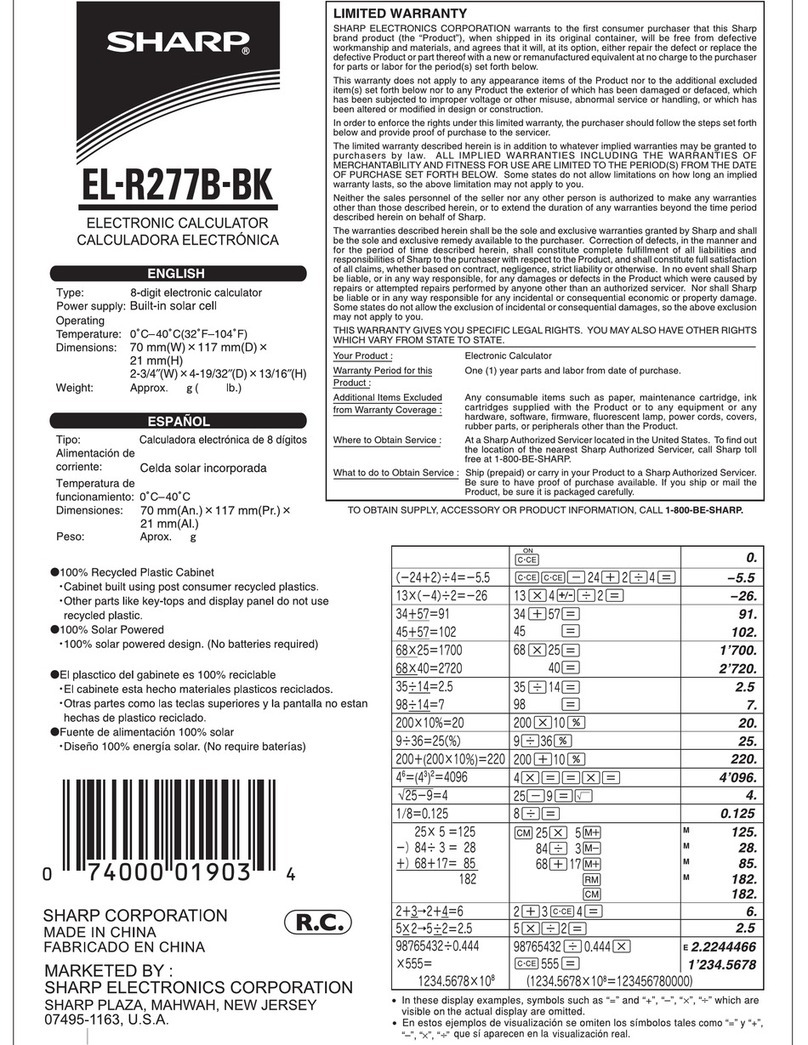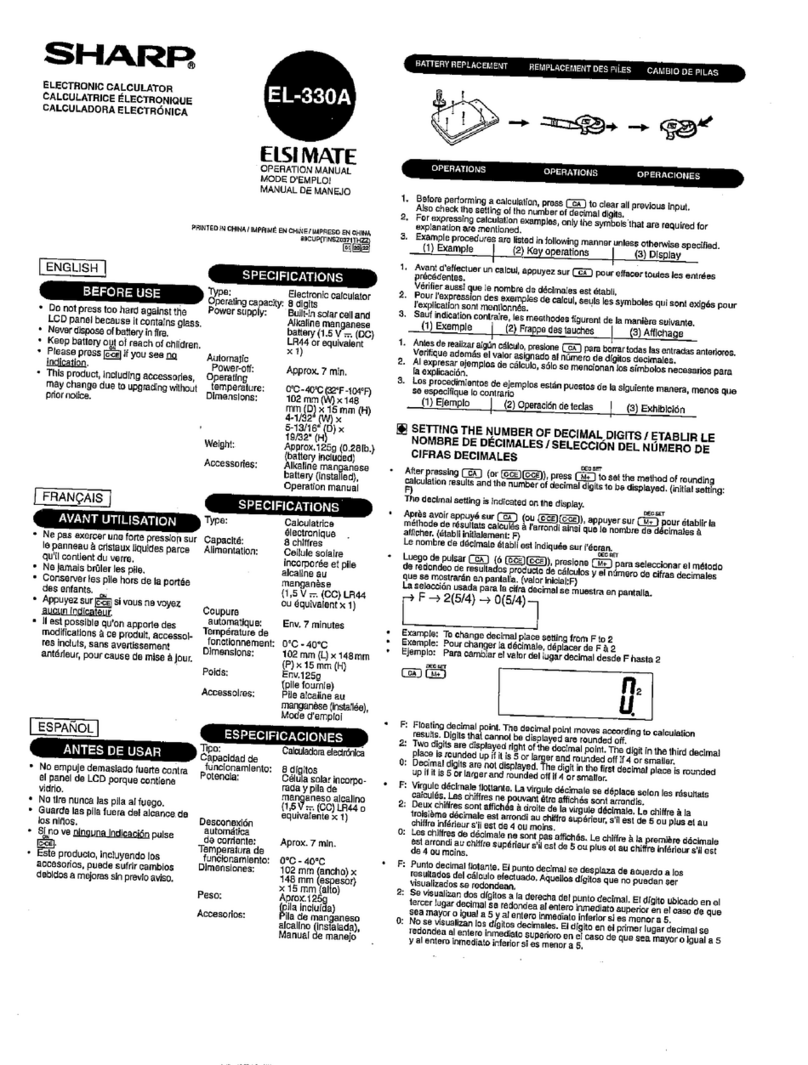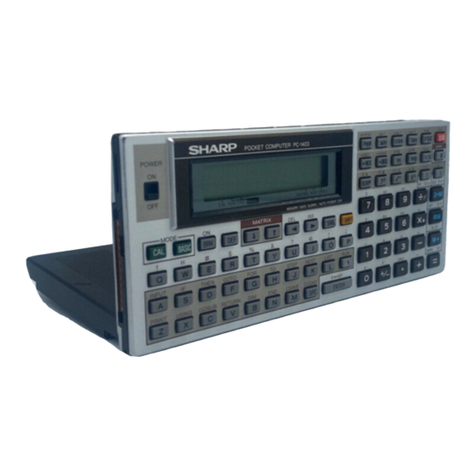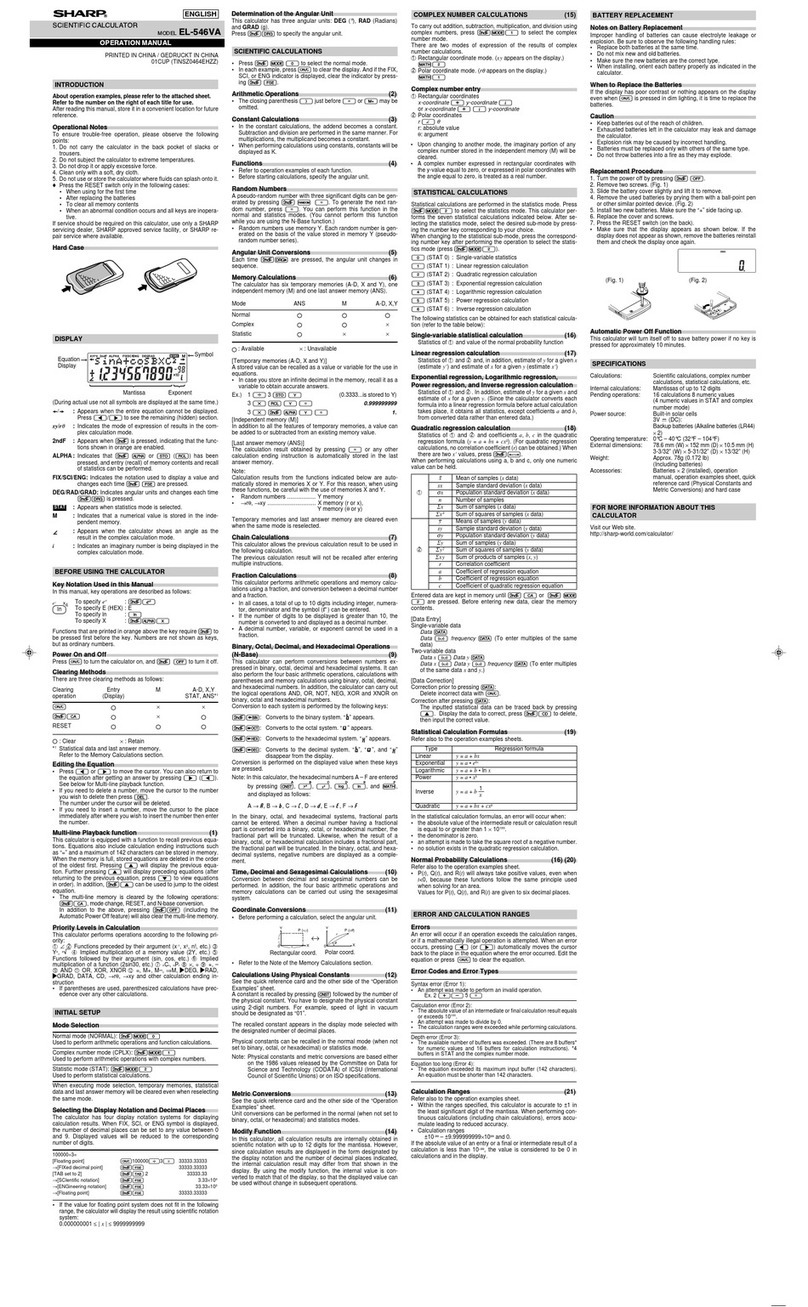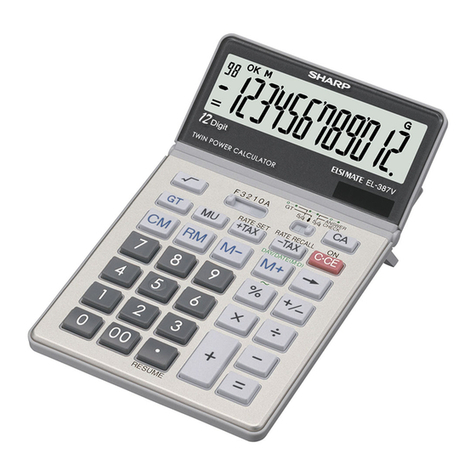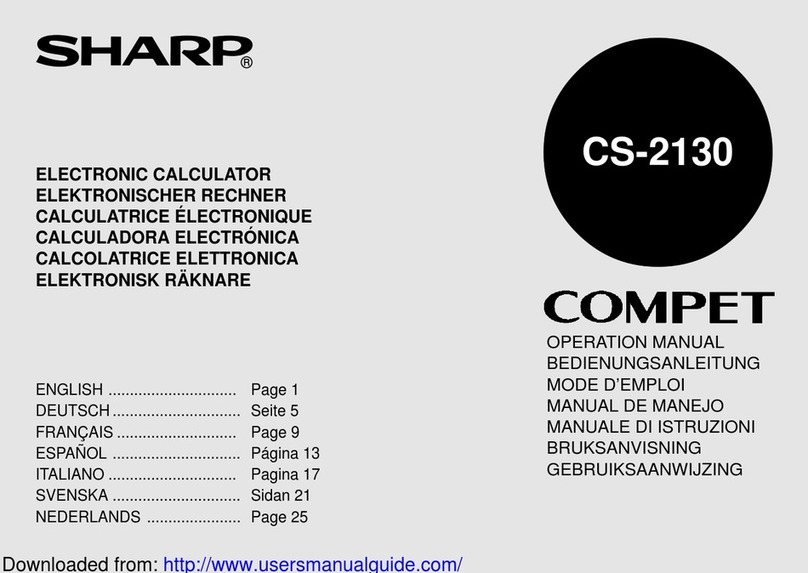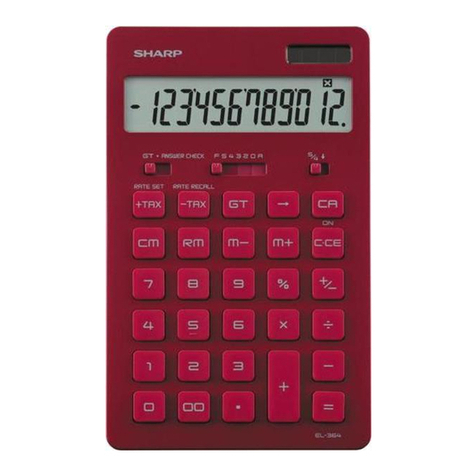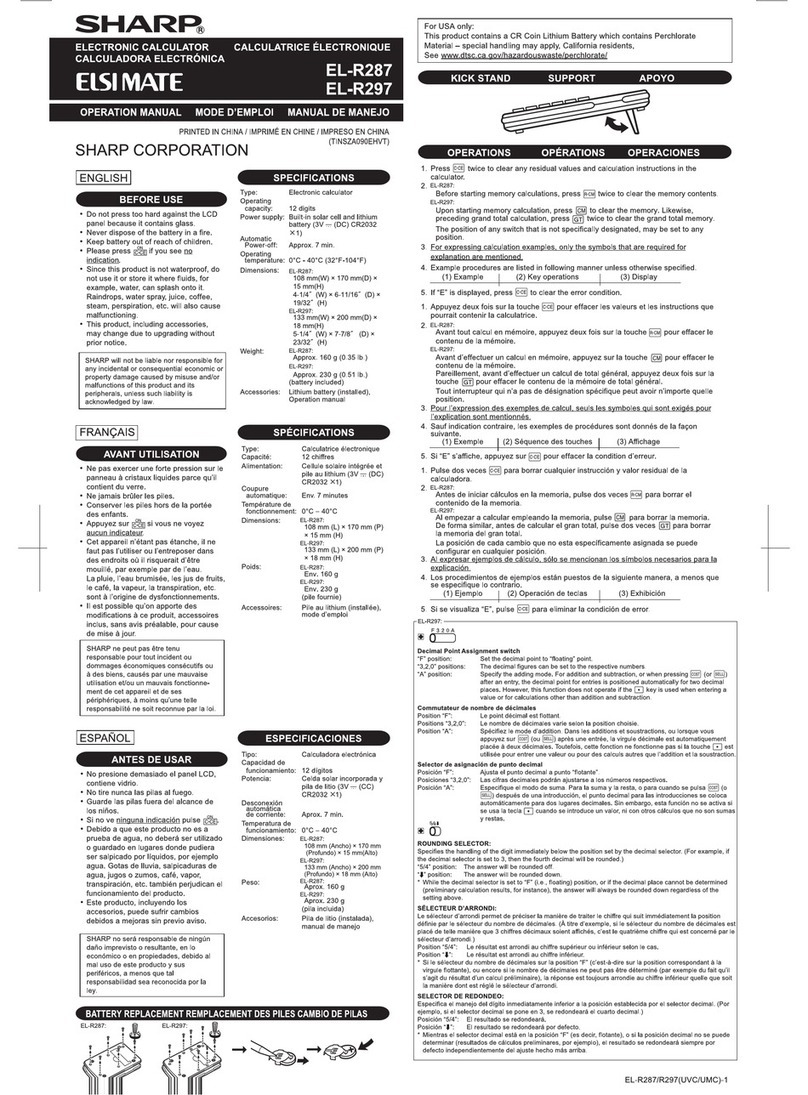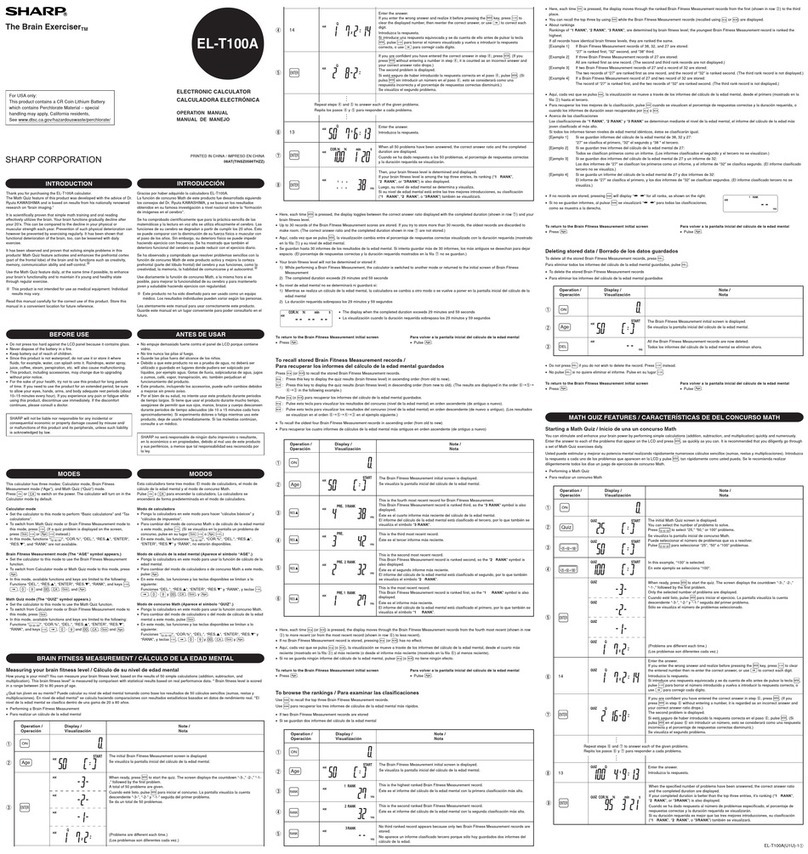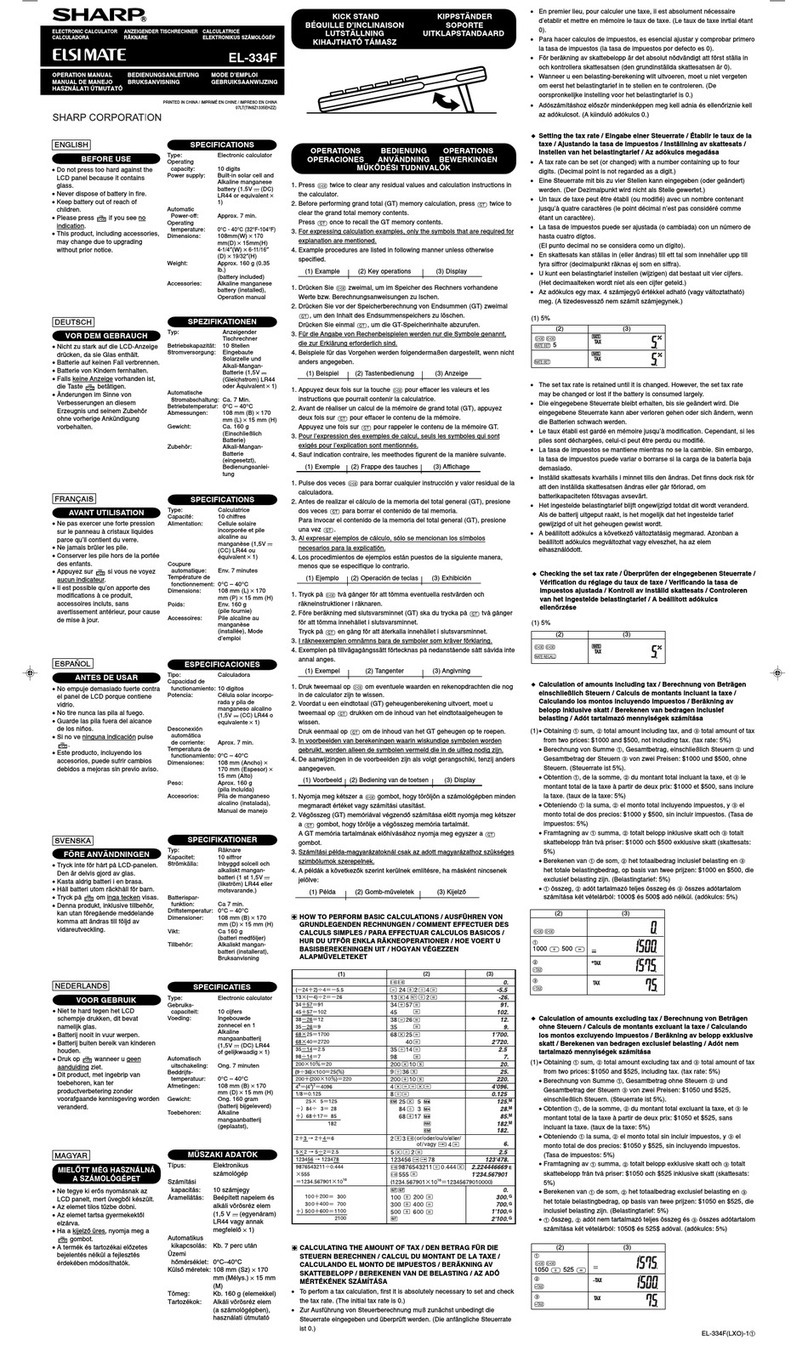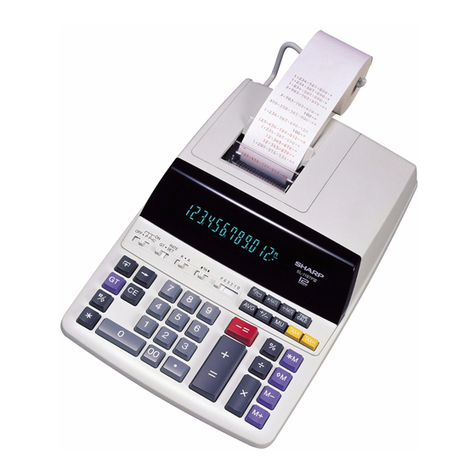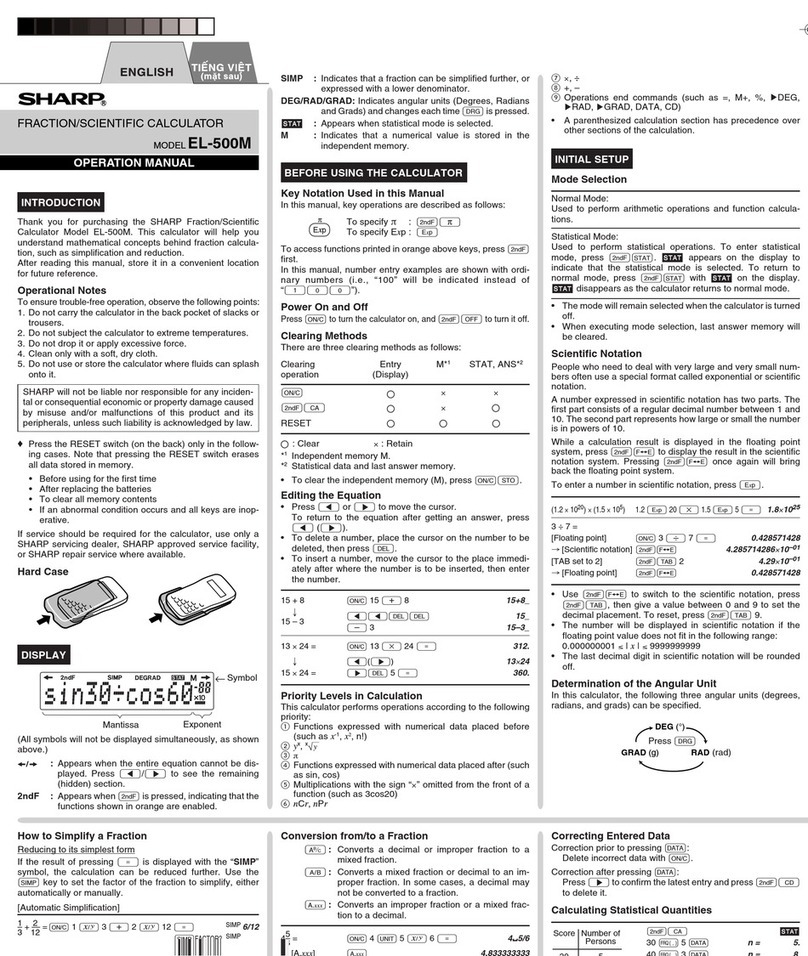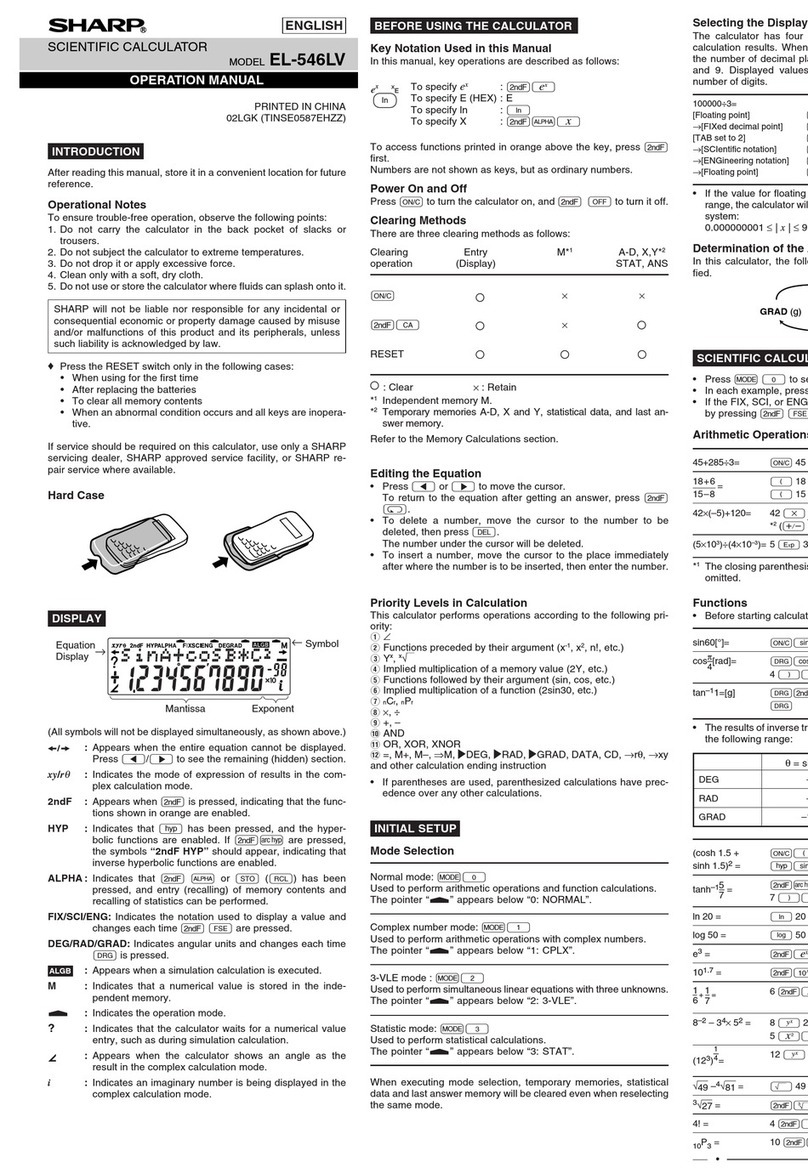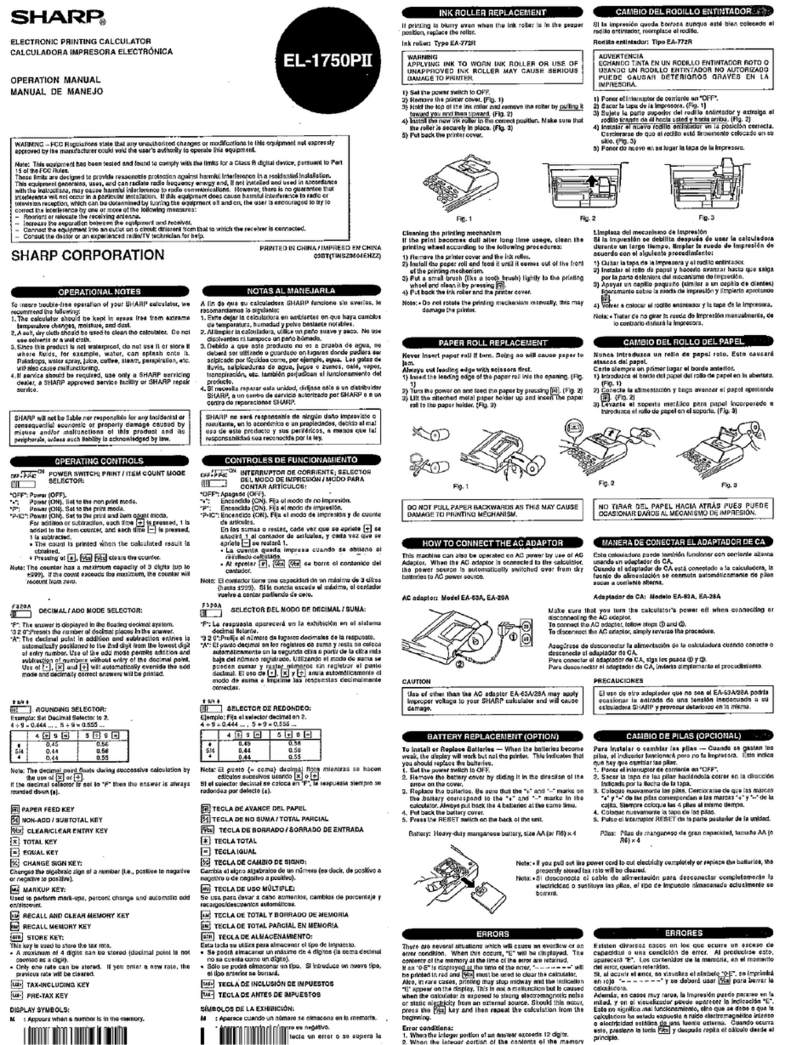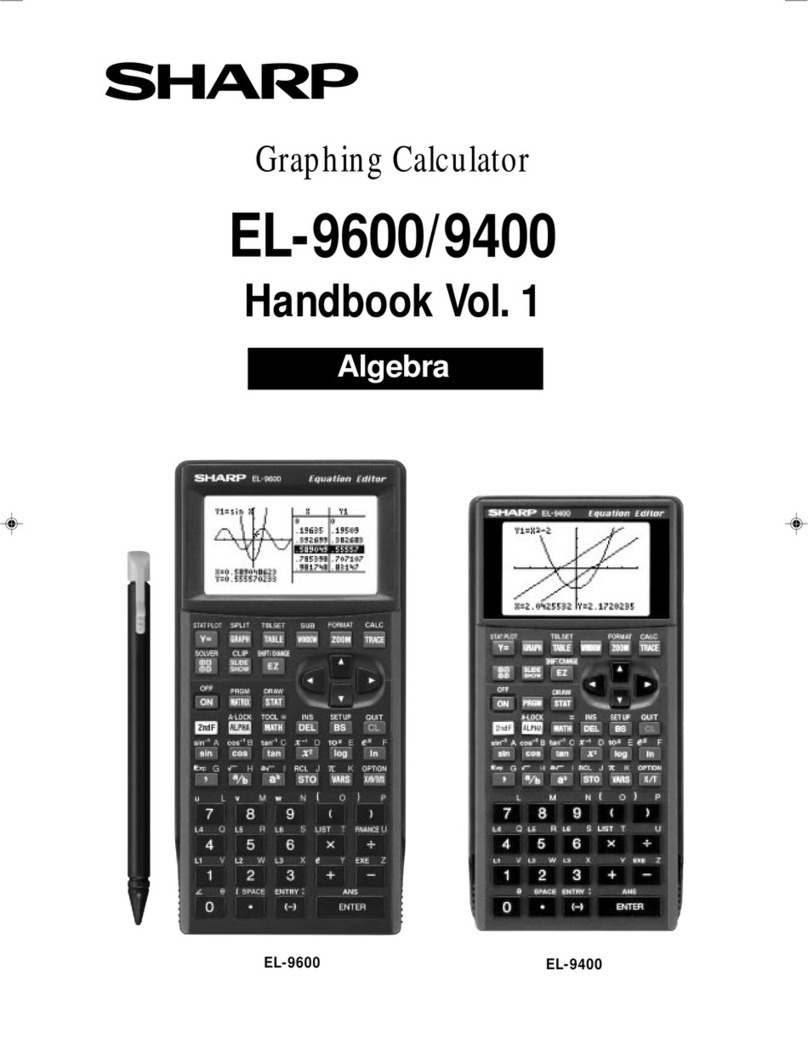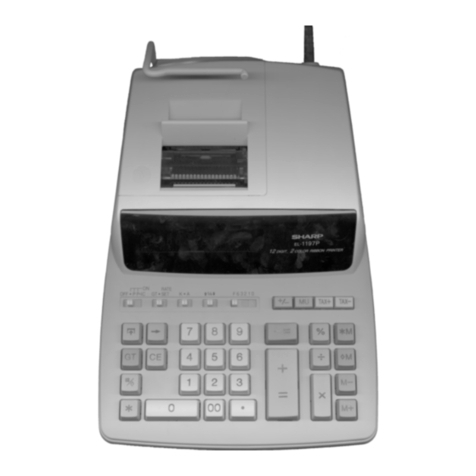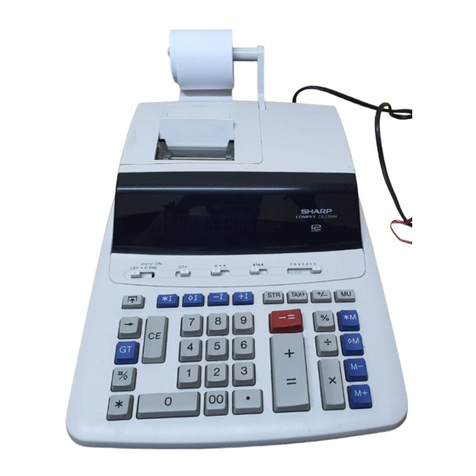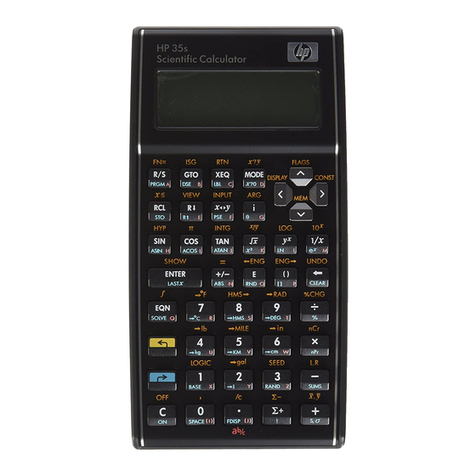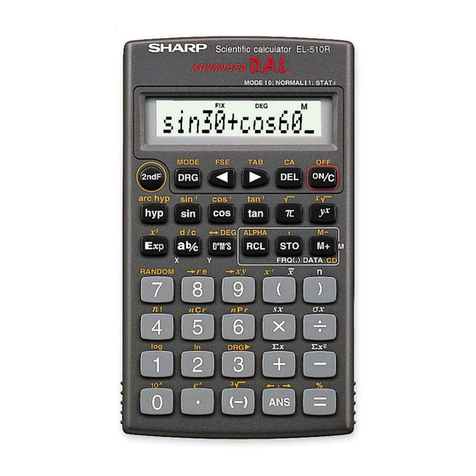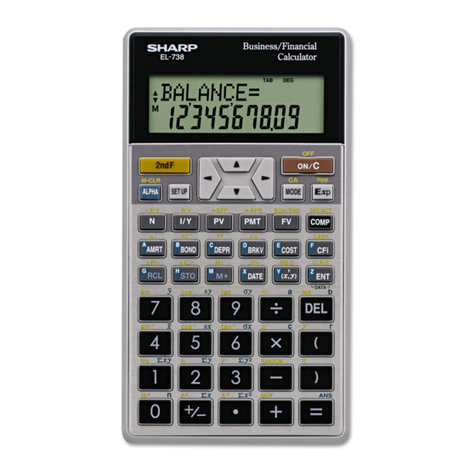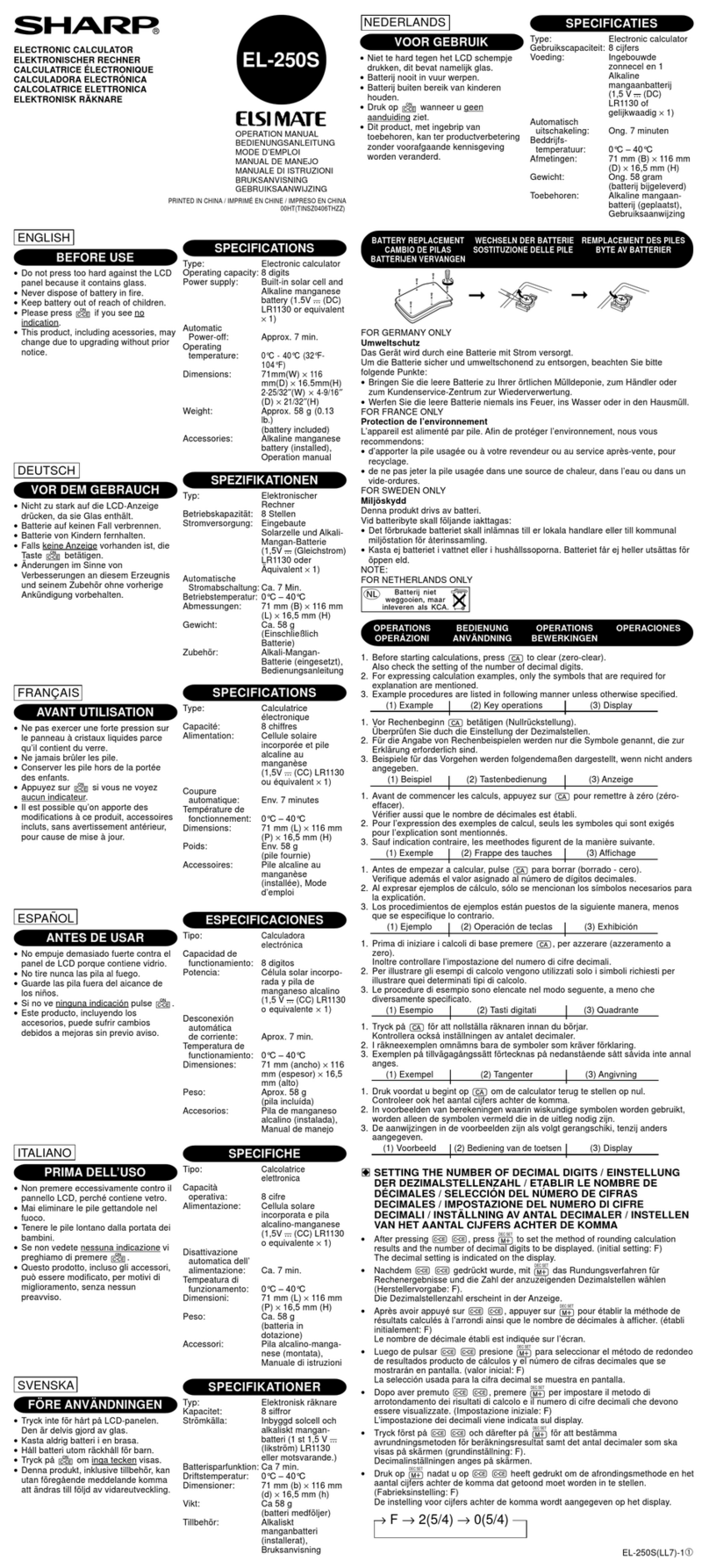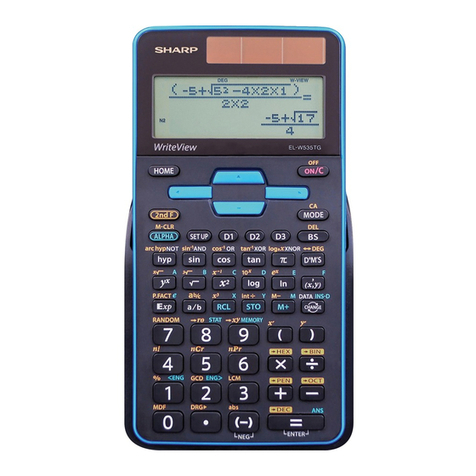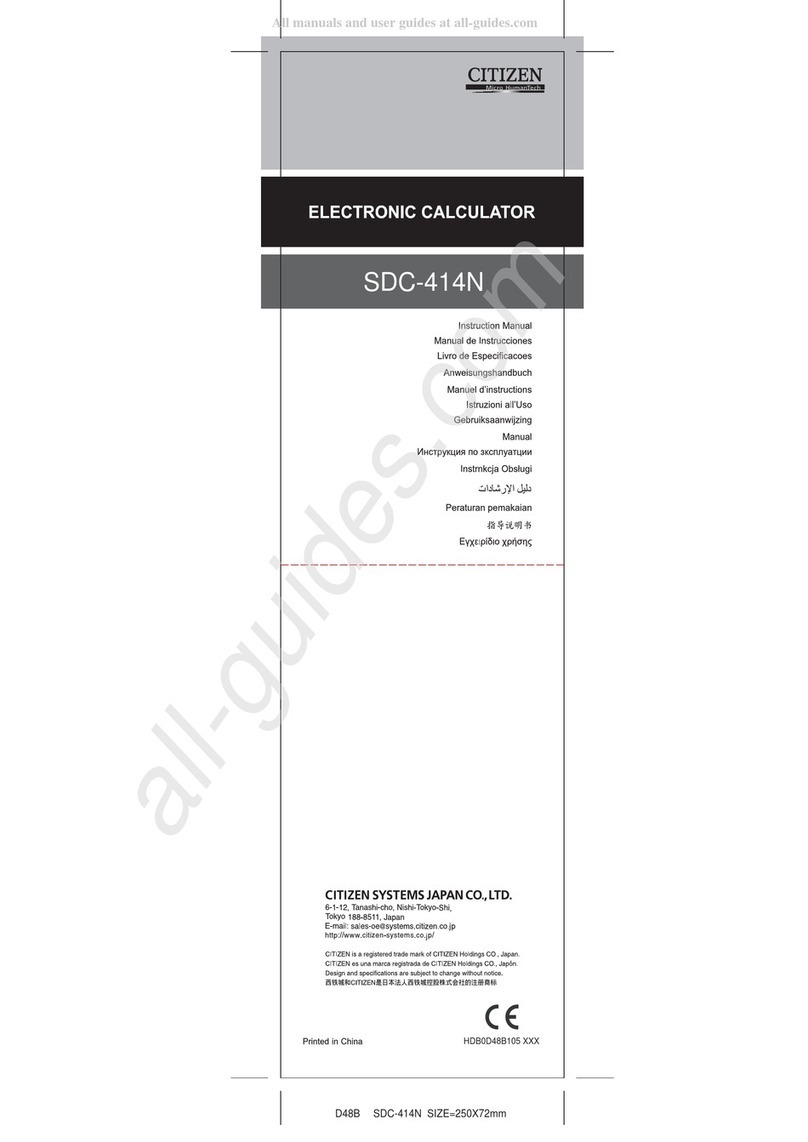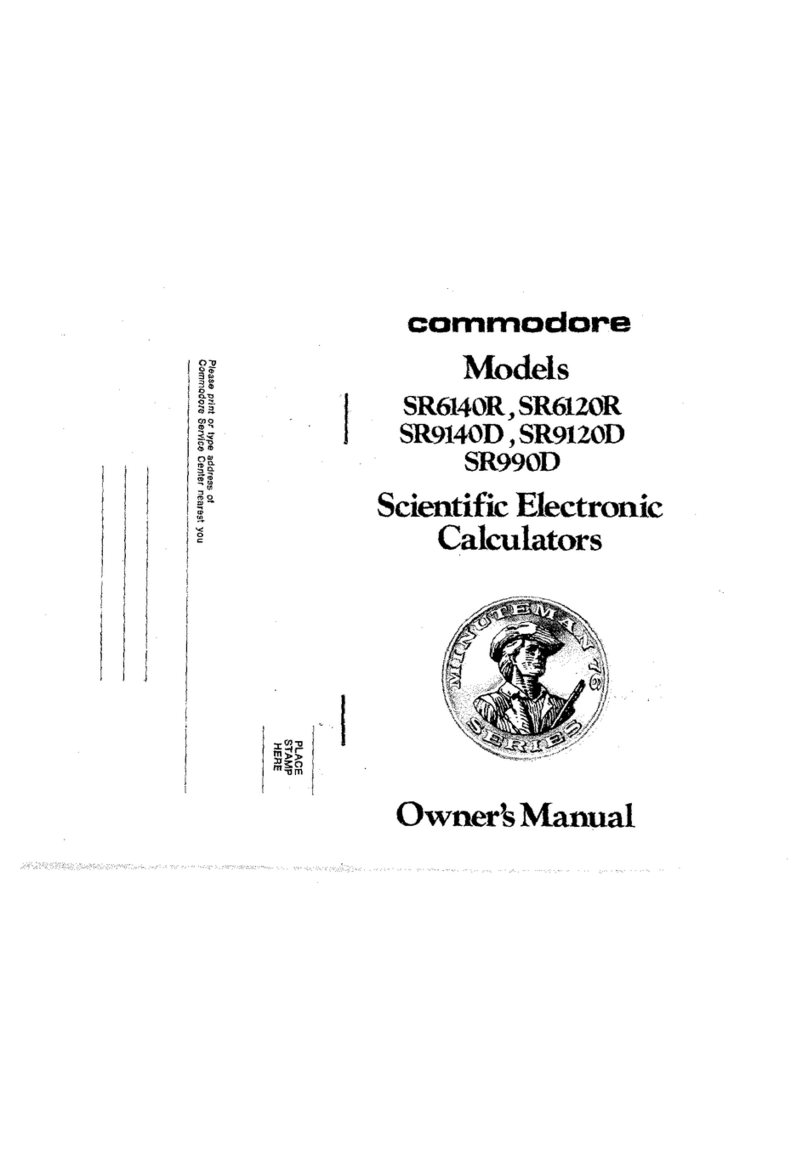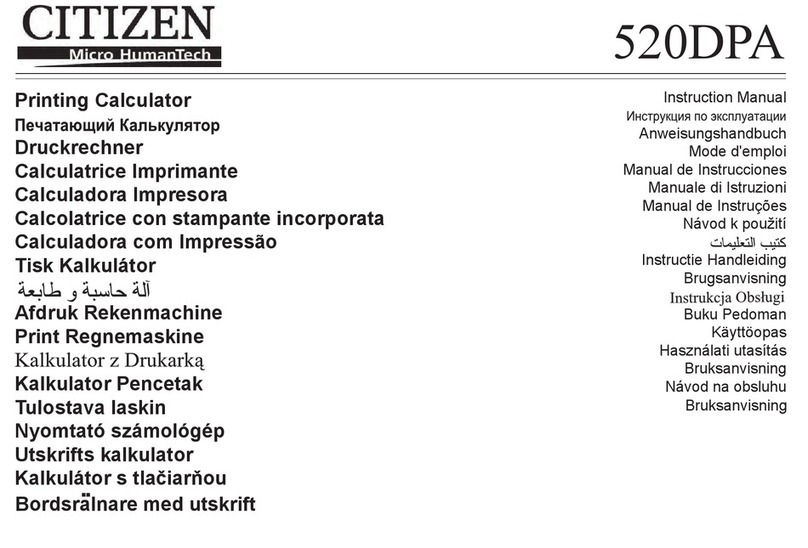
EL-503W_ENGLISH 370x540mm
EL-503W
FRACTION/SCIENTIFIC CALCULATOR
OPERATION MANUAL
MODEL
INTRODUCTION
Thank you for purchasing the SHARP Fraction/Scientific
Calculator Model EL-503W. This calculator will help you
understand mathematical concepts behind fraction
calculation, such as simplification and reduction.
After reading this manual, store it in a convenient location
for future reference.
Operational Notes
•Do not carry the calculator around in your back pocket, as
it may break when you sit down. The display is made of
glass and is particularly fragile.
•Keep the calculator away from extreme heat such as on a
car dashboard or near a heater, and avoid exposing it to
excessively humid or dusty environments.
•Since this product is not waterproof, do not use it or store
it where fluids, for example water, can splash onto it.
Raindrops, water spray, juice, coffee, steam, perspiration,
etc., will also cause malfunction.
•Clean with a soft, dry cloth. Do not use solvents or wet
cloth.
•Do not drop it or apply excessive force.
•Never dispose of battery in a fire.
•Keep battery out of the reach of children.
•This product, including accessories, may change due to
upgrading without prior notice.
SHARP will not be liable nor responsible for any incidental
or consequential economic or property damage caused
by misuse and/or malfunctions of this product and its
peripherals, unless such liability is acknowledged by law.
♦Press the RESET switch (on the back), with the tip of a
ball-point pen or similar object, only in the following cases.
Do not use an object with a breakable or sharp tip. Note
that pressing the RESET switch erases all data stored in
memory.
•When using for the first time
•After replacing the battery
•To clear all memory contents
•When an abnormal condition occurs and all keys are
inoperative.
If service should be required on this calculator, use only a
SHARP servicing dealer, SHARP approved service facility,
or SHARP repair service where available.
Hard Case
DISPLAY
•During actual use, not all symbols are displayed at the
same time.
•Only the symbols required for the usage under instruction
are shown in the display and calculation examples of this
manual.
:Appears when the entire equation cannot be
displayed. Press </>to see the remaining
(hidden) section.
2ndF : Appears when @is pressed, indicating that the
functions shown in orange are enabled.
x/y:Appears when xor ysolutions are displayed in the
equation mode.
Symbol
Mantissa Exponent
SIMP : Indicates that a fraction can be simplified further, or
entering a common denominator.
DEG/RAD/GRAD: Indicates angular units (Degrees, Radians
and Grads) and changes each time Gis pressed.
:Appears when equation mode is selected.
:Appears when statistical mode is selected.
M:Indicates that a numerical value is stored in the
independent memory.
BEFORE USING THE CALCULATOR
Key Notation Used in this Manual
In this manual, key operations are described as follows:
To specify π:@V
To specify Exp: E
To access functions printed in orange above keys, press @
first.
In this manual, number entry examples are shown with ordinary
numbers (i.e., “100” will be indicated instead of “10
0”).
Power On and Off
Press Nto turn the calculator on, and @F to turn it
off.
Clearing Methods
Operation Entry M*1STAT, EQN
(Display) ANS*2(Coefficients)
N×× ×
@c ×
Mode selection ×
RESET switch
: Clear ×: Retain
*1Independent memory M.
*2Statistical data and last answer memory.
•To clear the independent memory (M), press NO.
Editing the Equation
•Press <or >to move the cursor.
To return to the equation after getting an answer, press
<(>).
•
To delete a number/function, move the cursor to the number/
function you wish to delete, then press d. If the cursor is
located at the right end of an equation, the dkey will
function as a back space key.
•To insert a number, move the cursor to the place immediately
after where the number is to be inserted, then enter the
number.
15 + 8 N15 +8
15+8_
↓dd
15_
15 – 3 -3
15–3_
15 ×3 = N15 *3 =
45.
↓<
15
×
3_
15 ×6 = d6 =
90.
13 ×24 = N13 *24 =
312.
↓>
13
×
24
15 ×24 = >d 5 =
360.
Priority Levels in Calculation
This calculator performs operations according to the following
priority:
1Functions expressed with numerical data placed before
(such as x–1, x2, n!)
2yx, x¿y
3Functions expressed with numerical data placed after (such
as sin, cos, (–), ex, 10x, ¿)
4Multiplications with the sign “×” omitted from the front of a
function (such as 3cos20)
5nCr, nPr, GCF, LCM
6×, ÷, INT÷, mod
7+, –
8Operations end commands (such as =, M+, %, DEG,
RAD, GRAD, DATA, CD)
•Aparenthesized calculation section has precedence over
other sections of the calculation.
INITIAL SETUP
Mode Selection
Normal Mode:
Used to perform arithmetic operations and function calcula-
tions. In this mode, and do not appear on the
display.
Statistical Mode:
Used to perform statistical operations. To enter statistical
mode, press @”. appears on the display to
indicate that the statistical mode is selected. To return to
normal mode, press @” with on the display.
disappears as the calculator returns to normal mode.
Equation Mode:
Used to solve equations. To enter equation mode, press
@À and then 0or 1. appears on the
display to indicate that the equation mode is selected. To
return to normal mode, press @À with on the
display. The calculator returns to normal mode and dis-
appears from the display.
•The mode will remain selected when the calculator is turned
off.
•When executing mode selection, last answer memory will
be cleared.
Scientific (Exponential) Notation
People who need to deal with very large and very small numbers
often use a special format called exponential or scientific
notation.
A number expressed in scientific notation has two parts. The
first part consists of a regular decimal number between 1 and
10. The second part represents how large or small the number
is in powers of 10.
While a calculation result is displayed in the floating point
system, press @´ to display the result in the scientific
notation system. Pressing @´ once again will bring
back the floating point system.
To enter a number in scientific notation, press E.
(1.2 ×10
20
) ×(1.5 ×10
5
) 1.2
E
20
*
1.5
E
5
=
1.8
×
10
25
3 ÷ 7 =
[Floating point] N3 /7 =
0.428571428
→[Scientific notation] @´
4.285714286
×
10
–01
[TAB set to 2] @i 2
4.29
×
10
–01
→[Floating point] @´
0.428571428
•Use @´ to switch to the scientific notation, press
@i, then give a value between 0 and 9 to set the
decimal placement. To reset, press @i 9.
•The number will be displayed in scientific notation if the
floating point value does not fit in the following range:
0.000000001 ≤| x| ≤9999999999
•The last decimal digit in scientific notation will be rounded
off.
Determination of the Angular Unit
In this calculator, the following three angular units (degrees,
radians, and grads) can be specified.
SCIENTIFIC CALCULATIONS
•Select the normal mode.
•In each example, press Nto clear the display before
performing the calculation.
Arithmetic Operations
12+16×3= N12 +16 *3 =
60.
350–120÷4= 350 -120 /4 =
320.
72×(–12)–150= 72 *– 12 -150 =
–1’014.
(5+21)×(30–16)= (5 +21 )*
(30 -16 =*1
364.
(6×10
3
)÷(2×10
–4
)=
6 E3 /
2 E– 4 =
30’000’000.
*1The closing parenthesis )just before =or ;
may be omitted.
(rad)
Press G
Constant Calculations
•In constant calculations, the addend becomes a constant.
Subtraction and division are performed in the same manner.
For multiplication, the multiplicand becomes a constant.
•In constant calculations, constants will be displayed as K.
245
—
+60= N245 +60 =
305.
12
—
+60= N212 +60 =
72.
—
15×3= 15 *3 =
45.
—
15×10= 15-10 =
150.
Functions
•For each example, press Nto clear the display.
•Before starting calculations, specify the angular unit.
•The results of inverse trigonometric functions are displayed
within the following range:
sin60[°]= Ns 60 =
0.866025403
cos
–
π
4[rad]= Gu(@V/ 4
)=
0.707106781
tan–11=[g] G@T 1 =
50.
G
ln 20 = @I 20 =
2.995732274
log 50 = @l 50 =
1.698970004
e3= @e 3 =
20.08553692
101.7 = @¡ 1.7 =
50.11872336
32+ 52=3@L +5 @L=
34.
¿
32 + 3
¿
21 = ⁄32 +3 @$
21 =
8.415778426
74=7@™ 4 =
2’401.
4! = 4 @!=
24.
10P3= 10 @q 3 =
720.
5C2=5@Q 2 =
10.
–
π
3= @V/ 3 =
1.047197551
–
1
4+
–
1
5=4@• +5 @•=
0.45
200 ×32% = 200 *32 @%
64.
150 ÷ 300 = ?% 150 /300 @%
50.
200 + (200 ×32%) =
200 +32 @%
264.
300 – (300 ×25%) =
300 -25 @%
225.
Random Numbers
A pseudo-random number with three significant digits can be
generated by pressing @`=. To generate the next
random number, press =.
Angular Unit Conversions
Each time @g are pressed, the angular unit changes
in sequence.
90°→[rad] N90 @g
1.570796327
→[g] @g
100.
→[°] @g
90.
sin–10.8 = [°] @S 0.8 =
53.13010235
→[rad] @g
0.927295218
→[g] @g
59.03344706
→[°] @g
53.13010235
Memory Calculations
Mode M ANS
Normal
Statistical (STAT) ×
Equation (EQN) *1*1×
: Available ×: Unavailable
*1only available for memory recall
π
2
π
2
θ= sin–1 x
,
θ= tan–1 xθ= cos–1 x
DEG –90 ≤θ≤90 0 ≤θ≤180
RAD – —≤θ≤—0 ≤θ≤π
GRAD –100 ≤θ≤100 0 ≤θ≤200
This calculator has two memory allocations: independent
memory (M), and last answer memory (ANS). You will find
them especially useful when combinations of calculations
become complicated, or when using the answer of previous
calculation to another operations.
Press NO to clear the independent memory (“M”
symbol will disappear).
[Independent memory (M)]
O:Stores the result in the memory.
R:Recalls the value stored in the memory using
up to 14 digits in accuracy.
@; :Adds the result to the value in the memory.
N3 *5 O
15.
M
30 + (3 ×5) = 30 +R=
45.
M
(3 ×5) ×4 = R* 4 =
60.
M
20+10–5= N20 +10 -5 O
25.
M
121+13×2= 121 +13 *2 @;
147.
M
+) 21×3–16= 21 *3 -16 @;
47.
M
–—————
(Total) R
219.
M
NO
0.
M
[Last answer memory (ANS)]
When =is pressed, the calculation result will automati-
cally be stored in the last answer memory.
@? :Recalls the value stored in last answer memory.
4 ÷ 5 = 0.8…(A) N4 /5 =
0.8
4 ×(A) + 60 ÷ (A) =
4 *@?+ 60 /
@?=
78.2
Chain Calculations
•The previous calculation result can be used in the
subsequent calculation. However, it cannot be recalled
after entering multiple instructions.
6+4 = ANS N6 +4 =
10.
ANS + 5 = +5 =
15.
8 ×2 = ANS 8 *2 =
16.
ANS2= @L=
256.
Calculating the Greatest Common Factor (G.C.F.)
or Least Common Multiple (L.C.M.)
To calculate the G.C.F. or the L.C.M., the procedures are as
follows:
What is the G.C.F.
N24 œ36
24GCF36_
of 24 and 36?
=
12.
What is the L.C.M.
N15 ˆ9
15LCM9_
of 15 and 9?
=
45.
Calculating Quotient and Remainder
“:Calculates the quotient and remainder.
23 ÷ 5 = N23 “5
23
‘
5_
(R: Remainder) =
4. R3.
9.5 ÷ 4 = 9.5 “4
9.5
‘
4_
=
2. R1.5
–32 ÷ (–5) = –32 “– 5
–32
‘
–5_
=
6. R–2.
•“operation cannot be followed by another operation
such as (+, –, ×, ÷), otherwise an error will result.
•The calculator can display a quotient or remainder up to 5
digits in length, including the “–” sign. If a quotient or
remainder exceeds 5 digits, normal division is performed.
Calculating Remainder (Modulo Operation)
Ã:Find the remainder when a numerical value is
divided by a divisor.
What is the remainder
N5 Ã3
5mod3_
of “5 ÷ 3”?
=
2.
What is the remainder
N100 Ã8
100mod8_
of “100 ÷ 8”?
=
4.
FRACTION CALCULATIONS
Entering Fractions
•To enter fractions, use the following keys:
Ø:Places the symbol “
/
” between the numerator
and the denominator.
∞:Separates the integer (whole number) part
from the fractional part of a mixed number.
4
–
2
3= N2 Ø3 =
2/3
4
–
1
2= 4 ∞1 Ø2 =
4
¬¬
¬¬
¬
1/2
•Up to 10 key strokes, including “¬” and “
/
”, can be used
to enter a fraction.
Calculating with Fractions
Fractions can be incorporated into an arithmetic calculation.
The “SIMP” symbol will appear with a calculation result if the
answer can be further simplified. Refer to the following
section of this manual for details.
–
1
2+
–
1
3= N1 Ø2 +1 Ø3 =
5/6
–
2
5×
–
1
3= 2 Ø5 *1 Ø3 =
2/15
(
–
7
5)5=7Ø5 @™ 5 =
16807/3125
√
—
—
2
6
2
4
5
— = ⁄64 Ø225 =
8/15
How to Simplify a Fraction
[Reducing to its simplest form]
If the result of pressing =is displayed with the “SIMP”
symbol, the calculation can be reduced further. Use the
ªkey to set the factor of the fraction to simplify, either
automatically or manually.
Automatic Simplification
–
1
3+ —
2
12 = N1 Ø3 +2 Ø12 =
SIMP
6/12
ª
SIMP
FACTOR?
=*
SIMP
6_
=
1/2
*If you do not know a common factor, press =. The
greatest common factor “6” will be displayed.
Manual Simplification
–
1
3+ —
2
12 = N1 Ø3 +2 Ø12 =
SIMP
6/12
ª
SIMP
FACTOR?
2 =*
SIMP
3/6
ª3 =
1/2
*“2” is entered as a factor, and the “SIMP” will be displayed
to indicate further simplification of the fraction.
If the entered value is not a common factor, the cursor will
be set under the value. Press dto clear the value,
then enter a correct common factor. Press Nto return
to the “FACTOR?” display.
Now that you have learned how to reduce a fraction to
its simplest form, you can start using your calculator to
perform fraction calculations quickly and efficiently.
–
5
6+ —
1
14 = N5 Ø6 +1 Ø14 =
SIMP
38/42
=*
19/21
*If =is pressed instead of ª, the number will
automatically be reduced down to its simplest form with
the greatest common factor.
[Reducing to a common denominator]
Prior to pressing the =key, a common denominator can
be set to organize calculations.
–
1
3+
–
1
4= N1 Ø3 +1 Ø4
1/3+1/4_
ª
SIMP
DENOM.?
48 =*
16/48+12/48_
=
SIMP
28/48
*Enter a common denominator of the two fractions.
If the entered value is not a common denominator, the
cursor will be set under the value. Press dto clear
the value, then enter a correct common denominator.
Press Nto return to the “DENOM.?” display.
–
1
3+
–
1
4= N1 Ø3 +1 Ø4
1/3+1/4_
ª
SIMP
DENOM.?
=*
SIMP
12_
=
4/12+3/12_
=
7/12
*If =is pressed instead of a number entry, the least
common denominator will automatically be displayed.
Conversion from/to a Fraction
º:Converts a decimal or improper fraction to a
mixed fraction. In some cases, a decimal may
not be converted to a fraction.
æ:Converts a mixed fraction or decimal to an
improper fraction. In some cases, a decimal may
not be converted to a fraction.
ø:Converts an improper fraction or a mixed fraction
to a decimal.
4
–
5
6= N4 ∞5 Ø6 =
4
¬¬
¬¬
¬
5/6
→[A.xxx]ø
4.833333333
→[A/B] æ
29/6
1 ÷ 3 = 1 /3 =
0.333333333
→[A/B] æ
1/3
6 ÷ 5 = 6 /5 =
1.2
→[A/B] æ
SIMP
12/10
→[AB/C]º
SIMP
1
¬¬
¬¬
¬
2/10
→[A.xxx]ø
1.2
1.25 +
–
2
5= 1.25 +2 Ø5 =
1.65
→[AB/C]º
SIMP
1
¬¬
¬¬
¬
65/100
ª==
1
¬¬
¬¬
¬
13/20
STATISTICAL CALCULATIONS
To enter the statistical mode, press @”. The following
statistics can be obtained:
x
–: Mean of samples (x)
sx : Standard deviation of samples (x)
σ
x: Population standard deviation of samples (x)
n:Number of samples
Σ
x: Sum of samples (x)
Σ
x2: Sum of the squares of samples (x)
Entering Data
Entered data are kept in memory until @c or @
”are pressed. Before entering new data, clear the memory
contents.
To enter sample data, use the numeric keys and press
k(Okey) after each value.
To enter data with its frequency, use the numeric keys to
enter the value, then press §(Rkey), enter the fre-
quency, then press k.
Enter the data “7”
@”
@c 7
7_
k
n = 1.
*
There are 13 students
@c 70 §13
70, 13_
who scored 70 in the
k
n = 13.
test, and 5 students
50 §5
50, 5_
who scored 50.
k
n = 18.
*The number of samples for the entered data will be
displayed.
•If the digits of the sample values exceed 9, “n=” will not
appear.
•Inputting a formula as a sample value with frequency is
possible.
Example:
A
*
B
§
frequency
k
Correcting Entered Data
Correction prior to pressing k:
Delete incorrect data with N.
Correction immediately after pressing k:
Press >to confirm the latest entry and press @J
(Okey) to delete it.
If you want to delete any other data, enter the values again
and press @J to delete them.
Calculating Statistical Quantities
•If both the resulting digits and the function name (such as
Σ
x=) cannot be contained in the display, only the resulting
value will be displayed; the function name will not be
displayed.
Statistical Calculation Formulas
In the statistical calculation formulas, an error will occur if:
•the absolute value of the intermediate result or calculation
result is equal to or greater than 1 ×10100.
•the denominator is zero.
•an attempt is made to take the square root of a negative
number.
EQUATION SOLVERS
Simultaneous linear equations with two unknowns or quadratic
equations may be solved using this function.
1@À0:Simultaneous linear equation with two
unknowns (VLE)
a1x+ b1y= c1Coefficients: a1, b1, c1, a2, b2, c2
a2x+ b2y= c2Solutions: x, y
2@À1:Quadratic equation (QUAD)
ax2+ bx + c
= 0 Coefficients: a, b, c
Solutions: x
•Press ®after entering each coefficient (a1, a, etc.).
Coefficients can be entered using ordinary arithmetic
operations and functions.
•The solution (result) will be displayed after entering all
coefficients.
•In the input/display screen of coefficients and the display
screen of the solution (result), press Nto return to the
previous coefficient.
•To clear all the entered coefficients, press @c.
•The results obtained using this function may include a margin
of error.
•The solution of a quadratic equation is only a real number.
@À0
{
2x+ 3y= 4 2 ®3 ®4 ®
5x+ 6y= 7 5 ®6 ®7
x= ? ®x
–1.
y= ? ®y
2.
⇓ ®
{
2x+ 3y= 4 ®®®®®®
6x+ 7y= 10 6 ®7 ®10
x= ? ®x
0.5
y= ? ®y
1.
@À
@À1
3x
2
+ 4x– 95 = 0
3 ®4 ®– 95
first xvalue? ®x
5.
second xvalue? ®x
–6.333333333
⇓ ®
6x
2
+ 4x– 95 = 0
6 ®®®®
first xvalue? ®x
3.659716184
second xvalue? ®x
–4.32638285
@c
30 §5 k
n = 5.
40 §3 k
n = 8.
50 §10 k
n = 18.
60 §12 k
n = 30.
70 §13 k
n = 43.
80 §9 k
n = 52.
90 §7 k
n = 59.
100 §3 k
n = 62.
@÷
65.32258065
@£
18.52935128
@p
18.37931358
@n
n = 62.
@z
Σ
x
= 4’050.
@w
Σ
x
2
= 285’500.
Score Number of
Persons
30 5
40 3
50 10
60 12
70 13
80 9
90 7
100 3
Σx= x1+ x2+ ··· + xn
Σx2= x12+ x22+ ··· + xn2
(n: number of samples)
ERROR AND CALCULATION RANGES
Errors
An error will occur if an operation exceeds the calculation
ranges, or if a mathematically illegal operation is attempted. If
an error occurs, pressing <(or >) automatically moves
the cursor back to the place in the equation where the error
occurred. Edit the equation or press Nto clear the equation.
Error Codes and Error Types
Syntax error (Error 1):
•An attempt was made to perform an invalid operation.
Ex. 2 +- 5 =
Calculation error (Error 2):
•The absolute value of an intermediate or final calculation
result equals or exceeds 10100.
•An attempt was made to divide by 0 (or an intermediate
calculation resulting in 0).
•The calculation ranges were exceeded while performing
calculations.
•The solution of a quadratic equation is a complex number.
Depth error (Error 3):
•The available number of buffers was exceeded. (There are
10 buffers* for numeric values and 24 buffers for calculation
instructions). * 5 buffers in STAT and EQN mode.
Equation too long (Error 4):
•The equation exceeded the maximum input buffer (159 char-
acters). An equation must be shorter than 159 characters.
Calculation Ranges
•Within the ranges specified below, this calculator is
accurate to ±1 of the least significant digit of the
mantissa. However, a calculation error increases in
continuous calculations due to accumulation of each
calculation error. (This is the same for yx, x¿¿
¿¿
¿ˇˇ,
e
x,
n!
,
ln
,
mod
, etc. where continuous calculations are performed
internally.)
Furthermore, a calculation error will accumulate and
become larger in the vicinity of inflection points and
singular points of functions.
•Calculation range: ±10–99 ~ ±9.999999999×1099 and 0.
If the absolute value of an entry or a final or intermediate
result of a calculation is less than 10–99, the value is considered
to be 0 in calculations and in the display.
BATTERY REPLACEMENT
Notes on Battery Replacement
Improper handling of battery can cause electrolyte leakage
or explosion. Be sure to observe the following handling rules:
•Make sure the new battery is the correct type.
•When installing, orient the battery correctly as indicated in
the calculator.
•The factory-installed battery may be exhausted before
they reach the service life stated in the specifications.
When to Replace the Battery
If the display has poor contrast or nothing appears on the
display even when Nis pressed, it is time to replace the
battery.
Caution
•Fluid from a leaking battery accidentally entering an eye
could result in serious injury. Should this occur, wash with
clean water and immediately consult a doctor.
•Should fluid from a leaking battery come into contact with
your skin or clothes, immediately wash with clean water.
•If the product is not to be used for some time, to avoid
damage to the unit from leaking battery, remove it and
store in a safe place.
•Keep battery out of the reach of children.
•Exhausted battery left in the calculator may leak and
damage the calculator.
•Explosion risk may be caused by incorrect handling.
•Do not throw battery into a fire as they may explode.
Replacement Procedure
1. Turn the power off by pressing @
F.
2. Loosen both screws and remove the
battery cover.
3. Replace the old battery with new, with
the positive (+) sides facing up.
4. Replace the battery cover and screws.
5. Press the RESET switch on the back.
•Make sure that the display appears
as shown. Otherwise, remove the
battery, reinstall, and check the
display again.
Automatic Power Off Function
This calculator will turn its power off automatically if no key
is pressed for about 10 minutes.
SPECIFICATIONS
Calculations: General arithmetic operations,
statistical calculations, equation
solvers, etc.
Calculation method: D.A.L. (Direct Algebraic Logic)
Internal calculations: Mantissas of up to 14 digits
Pending operations: 24 calculations 10 numeric values
(5 numeric values in STAT and EQN
mode)
Power source: 1.5V ¶(DC):
Alkaline battery
(LR44 or equivalent) ×1
Power consumption: 0.0001 W
Operating time: Approx. 5,000 hours, when
continuously displaying 55’555. at
25°C (77°F).
May vary according to usage and
other factors.
Operating temperature: 0°C – 40°C (32°F – 104°F)
External dimensions:
78.6 mm (W) ×144 mm (D) ×11.6 mm (H)
3-3/32” (W) ×5-21/32” (D) ×15/32” (H)
Weight: Approx. 73 g (0.17 lb)
(Including battery)
Accessories: Battery ×1 (installed), operation
manual, quick reference card and
hard case.
FOR MORE INFORMATION
Visit us on the Internet at:
http://sharp-world.com/calculator/
Function Dynamic Range
sin xDEG : |x| < 1010
cos x(tan x: |x| ≠90(2n–1))*
tan xRAD : |x| < —– ×1010
(tan x: |x| ≠– ×(2n–1))*
GRAD : |x| < — ×1010
(tan x: |x| ≠100(2n–1))*
sin–1x, cos–1x|x| ≤1
tan–1x|x| < 10100
In x, log x10–99 ≤x< 10100
.y> 0: –10100 < xlogy< 100
yx. y= 0: 0 < x< 10100
.y< 0: x= n (0 < |x| < 1: – = 2n–1, x≠0)*,
–10100 < xlog |y| < 100
.y> 0: –10100 < – logy< 100 (x≠0)
x¿y.y= 0: 0 < x< 10100
.y< 0: x= 2n–1 (0 < |x| < 1: – = n, x≠0)*,
–10100 < – log |y| < 100
ex–10100 < x≤230.2585092
10x–10100 < x< 100
x2|x| < 1050
¿x0 ≤x< 10100
x–1 |x| < 10100 (x≠0)
n! 0 ≤n ≤69*
nPr0 ≤r ≤n ≤9999999999*
—
< 10100
nCr0 ≤r ≤n ≤9999999999*
—
< 10100
0 ≤r ≤69
nGCFn, nLCMn0 ≤n <1010
DRG DEG→RAD, GRAD→DEG : |x| < 10100
RAD→GRAD : |x| < – ×1098
1
x
1
x
1
x
1
x
π
180
π
2
10
9
* n, r: positive integers
π
2
n!
(n–r)!
n!
(n–r)!
